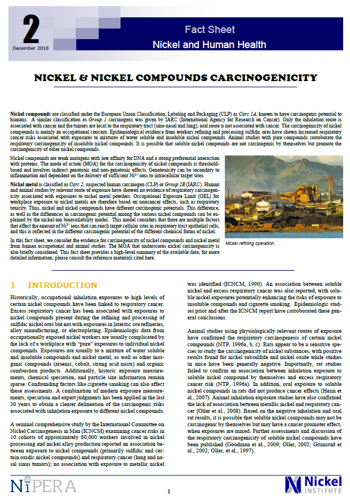Nickel compounds are classified under the European Union Classification, Labeling and Packaging (CLP) as Carc 1A, known to have carcinogenic potential to humans. A similar classification as Group 1 carcinogens was given by IARC (International Agency for Research on Cancer). Only the inhalation route is associated with cancer and the tumors are local to the respiratory tract (sino-nasal and lung); oral route is not associated with cancer. The carcinogenicity of nickel compounds is mainly an occupational concern. Epidemiological evidence from workers refining and processing sulfidic ores have shown increased respiratory cancer risks associated with exposures to mixtures of water soluble and insoluble nickel compounds. Animal studies with pure compounds corroborate the respiratory carcinogenicity of insoluble nickel compounds. It is possible that soluble nickel compounds are not carcinogenic by themselves but promote the carcinogenicity of other nickel compounds.
Nickel compounds are weak mutagens with low affinity for DNA and a strong preferential interaction with proteins. The mode of action (MOA) for the carcinogenicity of nickel compounds is threshold-based and involves indirect genotoxic and non-genotoxic effects. Genotoxicity can be secondary to inflammation and dependent on the delivery of sufficient Ni2+ ions to intracellular target sites.

Nickel metal is classified as Carc 2, suspected human carcinogen (CLP) or Group 2B (IARC). Human and animal studies by relevant route of exposure have showed no evidence of respiratory carcinogenicity associated with exposures to nickel metal powders. Occupational Exposure Limit (OEL) for workplace exposure to nickel metals are therefore based on noncancer effects, such as respiratory toxicity. Thus, nickel and nickel compounds have different carcinogenic potentials. This difference, as well as the differences in carcinogenic potential among the various nickel compounds can be explained by the nickel-ion bioavailability model. This model considers that there are multiple factors that affect the amount of Ni2+ ions that can reach target cellular sites in respiratory tract epithelial cells, and this is reflected in the different carcinogenic potential of the different chemical forms of nickel.
In this fact sheet, we consider the evidence for carcinogenicity of nickel compounds and nickel metal from human occupational and animal studies. The MOA that underscores nickel carcinogenicity is also briefly considered. This fact sheet provides a high-level summary of the available data; for more detailed information, please consult the reference materials cited here.
* Editorial credit: THPStock / Shutterstock.com
last updated: December 2018
© 2018, NiPERA Inc.
